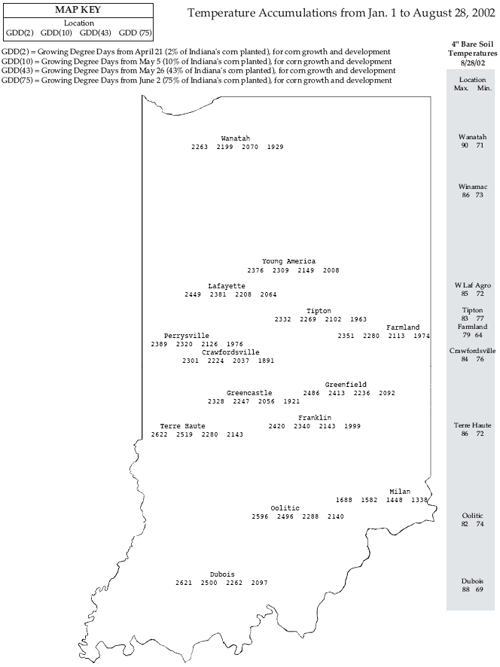Pest & Crop Newsletter
|
||||||||||||||||||||||||||||||||
Grain Bin Clean-Up- (Linda Mason and John Obermeyer)
Many grain bins have recently been emptied with higher market prices and preparation for this year’s harvest. Storage facilities should be readied for corn that will likely carryover to next spring or summer. Preparing bins for storage now goes a long way toward preventing insect infestations. Several species of insects may infest grain in storage. The principal insects that cause damage are the adult and larval stages of beetles, and the larval stage of moths. Damage by these insects includes reducing grain weight and nutritional value, and by causing contamination (as live or dead insects), odor, mold, and heat damage that reduce the quality of grain. Newly harvested corn may become infested with insects when it comes in contact with previously infested grain in combines, truck beds, wagons, other grain-handling equipment, augers, bucket lifts, grain dumps, or grain already in the bin. Insects may also crawl or fly into grain bins from nearby accumulations of old contaminated grain, livestock feeds, bags, litter, any other cereal products, or rodent burrows. Insect infestations can be prevented by employing good management practices. Now that many grain bins are empty, the following guidelines should be used before the 2002-grain is placed in bins:
Late Season Soybean Defoliators– (John Obermeyer, Rich Edwards, and Larry Bledsoe)
Observations of several soybean fields reveal that foliage feeders are plentiful. Bean leaf beetle, woollybear caterpillars, and grasshoppers have been seen. Bean leaf beetle will continue to feed on green leaves, then switch to green pods when the leaves begin to yellow. Though they don’t directly feed on the seed, their scarring allows for moisture to enter the pod and create a perfect environment for molds. Those growing soybean for seed should be scouting for this damage! See the following threshold for pod feeding. Numerous woollybears are crossing the county roads of Indiana (no, we can’t tell you what that means as far as this winter’s weather!). Areas in fields have been fed on, some with considerable defoliation. The good news is that they don’t feed on pods and that many of the worms are becoming diseased. Diseased woollybear appear frozen, and eventually the “hairs” fall off. Why did the woollybear cross the road?….to find a place to pupate and over winter! Grasshoppers will feed on both foliage and pods. However, their tendency is to move out of soybean fields once the foliage begins to senesce. Unlike bean leaf beetle, grasshopper pod feeding is complete removal of tissue, including the seed.
|
||||||||||||||||||||||||||||||||
Soybean Charcoal Rot- (Gregory Shaner and Gail Ruhl)
Several samples of soybean recently submitted to Purdue’s Plant and Pest Diagnostic Laboratory have been diagnosed as having charcoal rot. In the field, these plants appeared to be maturing prematurely, but did not show symptoms characteristic of sudden death syndrome or Phytophthora rot.
|
||||||||||||||||||||||||||||||||
Droopy Ears in Corn– (Bob Nielsen)
Ears of corn normally remain erect until some time after physiological maturity has occurred (black layer development), after which the ear shanks eventually collapse and the ears decline or ‘droop’ down. In recent weeks, corn field connoisseurs have reported droopy ears in fields that have not yet reached physiological maturity. Droopy ears are cute on certain breeds of dogs, but droopy ears on corn plants prior to physiological maturity are a signal that grain fill has slowed or halted. Premature ear declination (the fancy term for this problem) results in premature black layer formation, lightweight grain, and ultimately lower grain yields per acre. Impact on Yield? Remember that the ear shank is the final “pipeline” for the flow of photosynthates into the developing ear. An ear shank that collapses prior to physiological maturity will greatly restrict, if not totally prevent, the completion of grain fill for that ear and will likely cause premature black layer development in the grain. If the droopy ears you’ve looked have not black layered yet, they will soon. The timing of the onset of droopy ears determines the magnitude of the expected yield loss. If grain fill were totally shut down at the full dent stage of grain development (milk line barely visible at dent of kernels), the yield loss would be as much as 40 percent. If grain fill were totally shut down at the late dent stage of grain development (milk line halfway between dent and tip), yield losses for the affected ears would equal about 12 percent. Multiplying the percentage of affected ears in a field by the estimated yield loss per ear will give you an estimate of whole field loss. For example, if ten percent of the field contained plants whose ears drooped prematurely at the late dent stage, whole field loss would be estimated at 1.2 percent (10 percent of the ears multiplied by 12 percent yield loss per ear). Don’t forget, this and other timely information about corn can be viewed at the Chat ‘n Chew Café on the World Wide Web at <http://www.kingcorn.org/cafe>. For other information about corn, take a look at the Corn Growers’ Guidebook on the World Wide Web at
|
||||||||||||||||||||||||||||||||

|
||||||||||||||||||||||||||||||||




